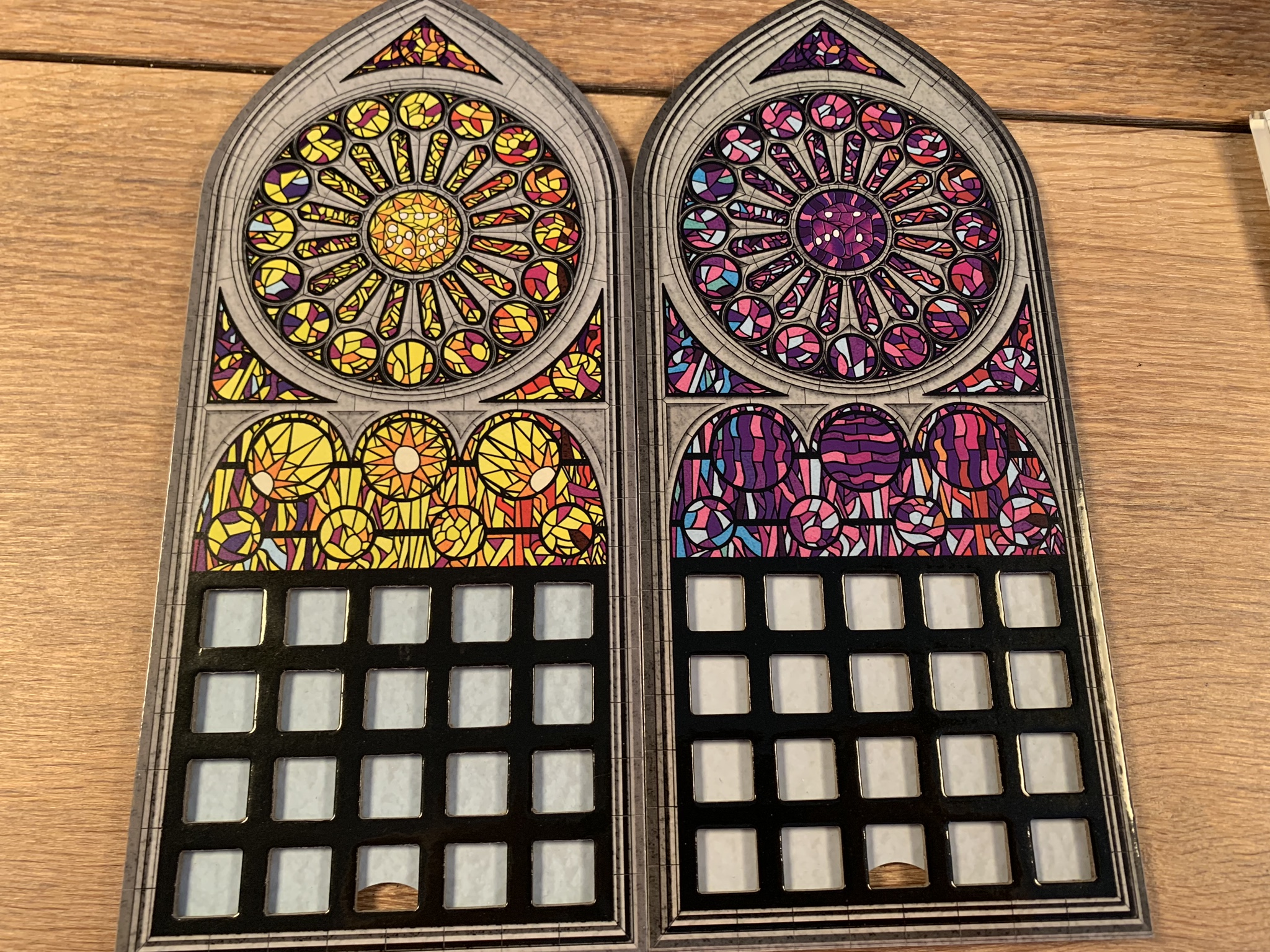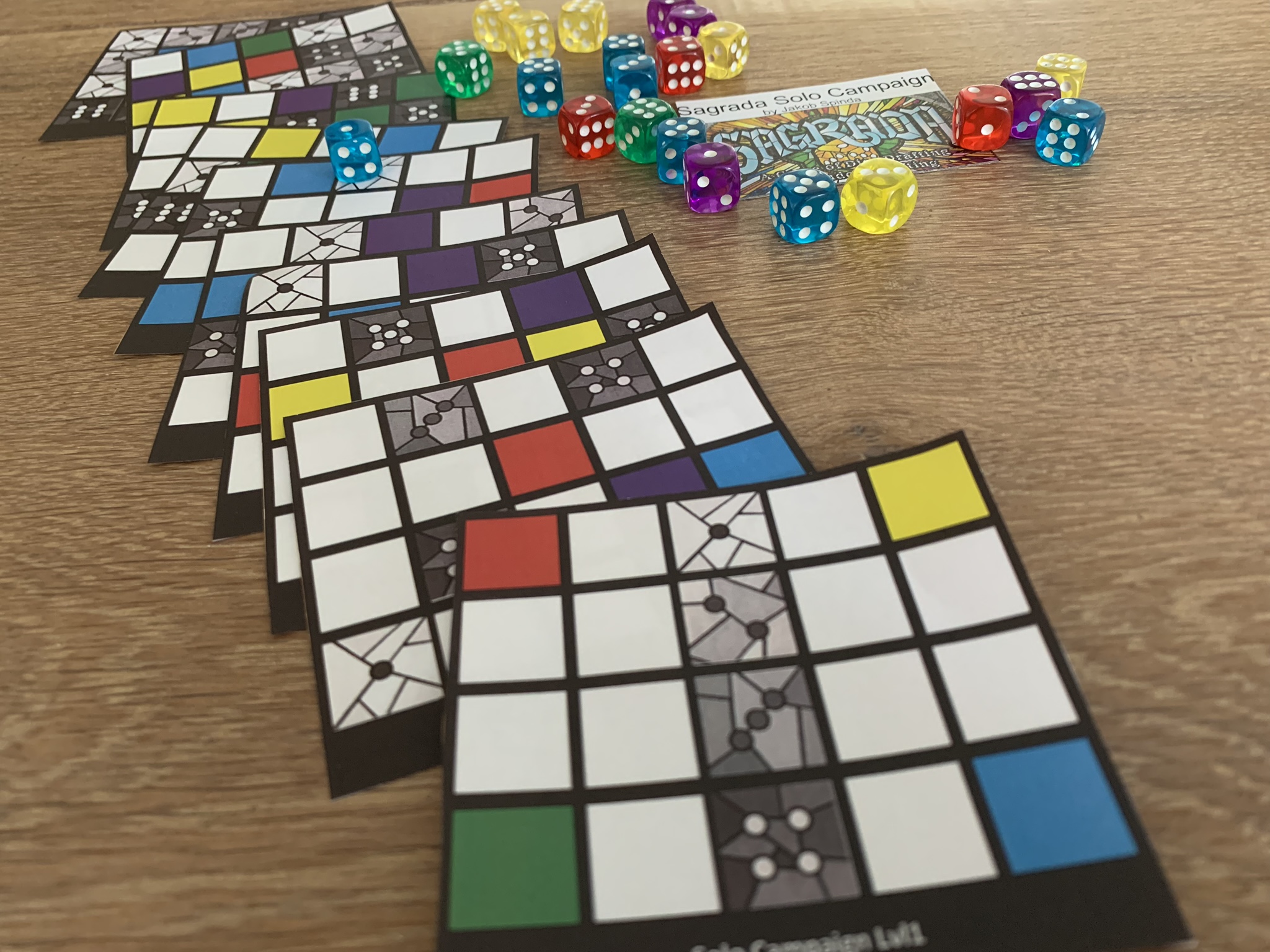
Can you do what builders couldn’t do for centuries; finish the Sagrada Familia in Barcelona?
Armed with dice in 5 colors, window patterns and a few selected tools, your simple task is to just finish one of the colorful window panes. But the architects has posed some rules about the visual appearances; no 2 colors or shade can be next to each other. As if that wasn’t enough, there are more builders competing to be the best window pane crafter; so you have secure the best materials for yourself.
Game overview
The game is played in 10 rounds and the pool of dice depends on the number of players. Going in clockwise order the first player rolls the dice and takes one to place immediately and then the next player takes one; this continues until the last player takes one. The twist here is that the last player takes 2 dice in a row and the drafting continues in counter clockwise order now; leaving the first player to choose between 2 dice for the finally drafting (unless someone skipped taking a die).
Placing your first die must be in the edge of the window pattern. All other dice drafted after this must be adjacent, which here also means diagonal, but keeping in mind that a die orthogonal adjacent to this must not be the same number or color as the die next to the other.
The rest of the restrictions for placing dice is according to the pattern on the selected window, color must match color and numbers must match the shade number printed on the pattern. Only a few randomly selected tools makes it possible to disregard some rules, but it comes with a cost. The first person to use a tool costs one favor token (which you get depending on the difficulty of the selected window pattern), all other uses after this costs 2.
Game: Sagrada
Player Count: 1-4
Max Playing Time: 45
Year Published: 2017
Rating: 7.4741
Designers: Adrian Adamescu, Daryl Andrews
Artists: Peter Wocken, ,
Mechanics: Contracts, Dice Rolling, End Game Bonuses, Grid Coverage
BoardGameGeek
How is it?
 (5 / 5)
(5 / 5)
I instantly got drawn to the beautiful colors of the dice and the artwork on the boards and cards. The game uses dice in a different way than I have tried before. You can still get very unlucky with your dice, but there are a few ways to change this, and depending on your private goal and the public goals available, you might still have a chance to win.
I like the interaction between players, and the special way you draft; so even though you are the last player, you get to draft 2 dice at a time, whereas, yes the first player gets to pick the first die, but then also gets the second die last (only choosing from 2 dice). If not it would be too great a benefit to go first. This game is also boyfriend approved, which brings up the rating of the game 🙂
![]()
Strategy & complexity
 (4 / 5)
(4 / 5)
The rules are very simple to grasp – though some are confused of the adjacency for the restrictions and the placement being different. Overall it’s very simple; just draft a dice and place it obeying placement rules.
The hard part is optimizing when you get a shitty die. Should you use the tools, which uses the favor tokens (which gives 1 point per unused token at the end of the game) to try and save your window or just pass on taking the die, as it might ruin more than getting a negative score for the holes in your window.
I think the most strategic part of the game is in the first few rounds; where do you start your window and where do you place the next die. After this you usually have most of the spaces reachable. The last strategic part is which die to draft; do you hate draft (take something others can you but doesn’t benefit you) or take the best that fits your window even though you are leaving some really good dice for the next player?
It’s not easy to satisfy all the public goals and your private goal to the fullest, and in many games, most people have holes in their window or they have ruined the public goals for themselves; mostly without realizing too late (when scoring).
For the solo game there is a new element of strategy; here it is vital which dice you leave for the AI, as this will be the score to beat. Using all the tools available seems to be a must in order to get a chance to beat the AI; and I say “chance”, as it’s quite difficult and I have not won many games.
![]()
Replayability
 (4.5 / 5)
(4.5 / 5)
The replayability is really high; the window patterns, tool cards and goal cards are random every time and there a few to choose from. The dice rolling makes this a new game every time – when you just get that perfect die in the last round, you feel like excited.
I would say for solo game, as I will mention more in that section, the replay is not as good; sure it’s random, but you know from the beginning you will loose if you start with public goals that doesn’t give you many point for your efforts. The best goals to start with is those that give you 5-6 per requirement met.
5-6 player expansion
The 5-6 player part doesn’t do more than it claims, adding components to play 5-6 player. It does add a few extra personal goal cards so the pool of goals are bigger. I was really looking forward to playing with more than 4 players, as I always thought this could easily be played with more; and often in my game group we are more than 4. Of course the game length is longer, but the game itself doesn’t suffer from being played with 6 players. Only thing to keep in mind is that you can almost be certain now that the die you want disappears before it’s your turn again.
The dice pool module I have not tried yet, but seems to be an extra way of strategic planning and helping you if you end up with a shitty die; just switch it out with one from your private dice pool. I really like that you can still do a little something to manipulate a bad die.
Sagrada: The Great Facades – Passion
The first of 3 Facades exansion. It contains 3 modules, which you can integrate as you see fit.
One of the modules is the beautiful shimmering dice; one is added with a special tile on how to acquire this. With this new private objective based on the rare glass die are added.
Another module is the inspiration cards, which is a fancy word for player powers – some you can active once, some every round; examples are manipulating the drafted die.
The last module is the asymmetric public objectives; which is a nice touch to give some variety.
![]()
Scalability
 (5 / 5)
(5 / 5)
The game scales really well from solo game, 2 players and even up to 6 players with the expansion. Yes it can take a longer time with 6 people having to think and even 4 players, but you still feel engaged, as you are hoping they don’t take the die you need.
I really like it as a 2 player game as well, and it’s even boyfriend approved. The back and forth gives a good dynamic.
Solo game has a bit different feel, as in you are focusing more on what dice you don’t take; leaving these for the AI.
![]()
Rules & accessibility
 (5 / 5)
(5 / 5)
Straightforward rules and the only questions we had were for some of the tool cards. An appendix with examples would have been top notch. I really like that the rules are short and precise and simple, yet the game has more depth to it than you think.
It is easy to get people to start playing, but many have a difficult time understanding that for placement of a die adjacency also means diagonal but for checking if the adjacent die is the same color or number, it’s only orthogonal adjacent and not diagonal, which counts. Usually they get it after a few rounds.
I like that it’s played in a set amount of rounds, 10, you can always follow when the game ends and you know if you don’t take 2 dice every round you will get holes; without having the possibility to catch up.
![]()
Solo variant
 (4 / 5)
(4 / 5)
I really appreciate that there is a solo mode and it works almost as the multiplayer game with just a few easy modifications and you can get started. What I don’t like is, what I already mentioned that you almost know when you start the game and see the public goals and the tool cards that you have lost. It’s a hard game to beat, even on easy mode (having 5 tool cards available), but having goal cards that score high is essential for beating the game. Using all tool cards to get rid of a die for the AI and giving the AI the smallest possible values is the key to winning. With this being said it’s a good puzzle, and some games end quite close.
Unofficial variant (Solo “Campaign)
I’m not sure why I tried this 10 card challenge, since I rarely win, but I thought maybe the new windows patterns could help me. I of course ended up loosing (even though I played some of it wrong, which should have helped me), but it was a nice breath of fresh air. Maybe giving the player some extra benefits after finishing cards would make it a bit easier to beat it.
![]()
Remote playability
 (5 / 5)
(5 / 5)
I have played this game several times over skype/google hangout, where I host the game on my table and move all the pieces for the everyone. Where the difficulties lie is mostly the transparent dice that can be a bit harder to watch via screen, especially if the light reflects them. I have used some colored tokens (the bunnies from Dixit have the required colors to match) next to them to help distinguish them, the numbers on the dice can still be hard to tell, especially on the yellow dice; but then I just tell them the values.
Other than that is works really well and we had fun with it. Only tried with 3 players as the space can be a problem when everyone needs to see their own window, the dice available and the others windows. One thing you could do is using the window patterns without the holder to make it take up less space and reduce the glare from the holder.
![]()
Portability
 (4 / 5)
(4 / 5)
If packing light, you could travel without the holders for the window pattern, which would make the game take up very little space; with the dice taking up most. I have not tried it, but something I would defiantly do, if we wanted to take it on holiday with us. For all other travels I would recommend taking the pattern holder as it really lights up the room with the pretty colors and the dice are more secure in there.
![]()
Appearance & component quality
 (5 / 5)
(5 / 5)
The components are really well done. Nice pattern holder, great quality of dice, although people with bigger hands have remarked a bit about them being so small; even if you don’t have big hands, you can easily push the other dice in your window pattern, when you are trying to move an already placed die or just checking what is underneath the die in order to decide, if it can be moved to help you.
Nice favor tokens and cards. Only tiny thing is the scoring markers are so small I’m afraid they will get lost.
The insert is good to keep everything organized and it even has room for the expansion. With the expansion you also got this nice little dice tray to roll the dice in and pass them to the next player. As I understood, if you backed it on Kickstarter, you also got the dice tray. It is really handy to have, especially if you were to play with 6 players, as it can be hard to see all the dice from every angle.
Helge’s review
(and Birger)
The box lid has a really good size; I have all my limps well secured in the box, but staying there for a long time would make it hurt too much. But I prefer a small nap in a tight box, rather than a box that is too big with too much room.
The box could have been thicker and I’m not sure how long it will last, but it also doesn’t feel thin.
Components are great; I love dice, as you can really mess up the game in many ways; pushing the dice away or just slightly touching as to change the value of them. The dice could become a bit dangerous for me, as they are small enough to eat. Cards are always a nice touch as they slide really well with just the slightest touch of my paw.
| Box Fitting: |  (3.5 / 5) (3.5 / 5) |
| Component Noise: |  (4.5 / 5) (4.5 / 5) |
| Component Count & Diversity: |  (5.0 / 5) (5.0 / 5) |
| Component Quality: |  (4.0 / 5) (4.0 / 5) |
| Human Annoyance Level (HAL): |  (5.0 / 5) (5.0 / 5) |
| Average: |  (4.4 / 5) (4.4 / 5) |
Game info
Rules explanation





















